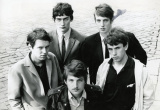Unfulfilled Promises
The Dutch Film Academy produced a number of promising directors in its first years (around 1965).These were young filmmakers who were to be the leaders of a new generation that was going to shake up the Dutch film world. Just as abroad, these directors opposed the established film culture and believed in making major changes, most importantly in the area of film production. In the words of Pim de la Parra and Wim Verstappen, the driving forces behind the production company Scorpio Films: ‘It doesn’t matter what you film or how you film it – as long as you film it. Better to make ten poor films than none at all.’
A New Crop
A group of like-minded film students formed around De la Parra and Verstappen. The newly established magazine Skoop became their official organ and the short film was their medium of choice – with or without financial support from the funding organisations for short and artistic films. They generated a number of high-quality short films, with highlights such as Ik kom wat later naar Madra (1966) by Adriaan Ditvoorst and Een middag op het eiland van de Grande Jatte (1965) by the relative outsider, Frans Weisz.
These short films showed the new generation’s talent and within no time they were producing their first feature films. The first to come with a full-length film was Nikolai van der Heyde: Een ochtend van zes weken. This was followed by Wim Verstappen’s De minder gelukkige terugkeer van Joszef Kâtus naar het land van Rembrandt and Adriaan Ditvoorst’s Paranoia. These films irrefutably demonstrated the new generation’s qualities and received positive reviews both at home and abroad. A fresh wind was blowing through the Dutch film world, and the future looked promising.
The Tide Turns
Things would turn out differently, however. The promising careers of Ditvoorst and Van der Heyden certainly never developed as hoped. Ditvoorst turned out to be too stubborn to make compromises. After a number of his films received mixed reviews – including Flanagan and Mantel der liefde -- the baroque De witte waan was released in 1983. It would be his last film. A few years later he committed suicide in his hometown of Bergen op Zoom.
Van der Heyde’s situation was less tragic, but he, too, was unable to channel his talent into a successful career. After Een ochtend van zes weken came To Grab the Ring and Angela, two idiosyncratic films. After that he teamed up with producer Henk Bos to make Help, de dokter verzuipt, adapted from a novel by Toon Kortooms. The film was a hit, drawing more than a million viewers. Van der Heyde made two more films, but these were both commercially and artistically inferior. A failed attempt at a comeback in the 1980s with a film called Nitwits meant the end of a career that had started out so promisingly twenty years earlier.
Caught in the turbulent waters between artistic integrity and having to make a profit, both of these filmmakers foundered.
For a while it looked like Frans Weisz’s career might end up the same: after his daring debut – Het gangstermeisje – he made a series of popularfilms with varying success. Both De inbreker and Rooie Sien drew more than half a million viewers, but after the miserable failure of his film Heb meelij, Jet!, it looked like he would be written off as a filmmaker. He came back strong in 1981, however, with the Dutch-German co-production Charlotte. This new beginning was followed with the successful film Leedvermaak and the television series Bij nader inzien.
more information
If you are looking for more material from our collection, please contact Film Sales:
sales@eyefilm.nl
phone +31 (0)20 5891 426

